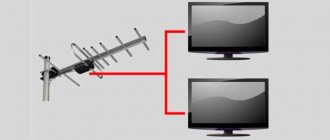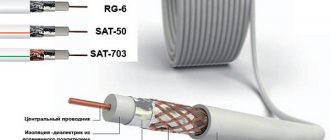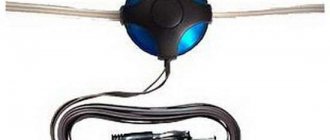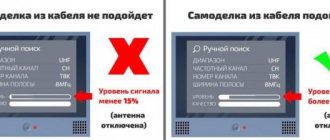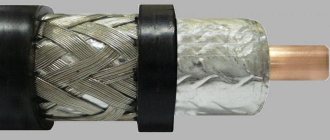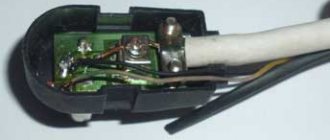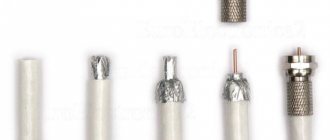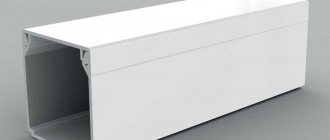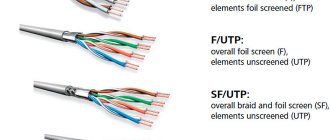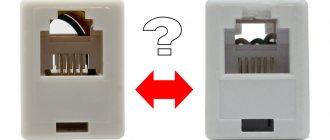- home
- How to install a connector on a coaxial cable: preparation, wrapping and crimping
Coaxial cables are used to transmit cable television signals. Most of their connection options (cable splicing, as well as connecting the cable to a splitter) involve the use of so-called F-connectors. In these threaded connectors, the role of one of the contacts is performed by the central core of the coaxial cable. The outer shielding shell is attached to another contact of the connector (which is also a threaded connection) without the use of soldering, by crimping or twisting.
Features of cable routing
The television cable “comes” into the apartment from the floor panel and is routed through the television receivers available in the house. To correctly install a TV cable throughout your apartment, you should follow some recommendations.
The main elements of a TV cable in stripped and completely exposed form
To avoid signal interference, it is recommended to place the cable away from the electrical wiring. Telephone wire or Internet cable do not interfere with the normal passage of the TV signal, and therefore the general installation of these communications in one cable channel is allowed. If it is impossible to avoid placing an electrical cable together with a television cable, then you should purchase a TV cable with a core diameter of over 1 mm with a double protective screen.
Cable routing across rooms to ensure shielding and high quality contacts is carried out using factory-made splitters. Self-made devices are unlikely to be able to provide acceptable signal quality. You should also avoid connecting a television cable with sharp bends or in a coil - the quality of the picture on the screen may suffer greatly from this.
It is better to lay the section of the line running from the floor box to the apartment in a widened cable channel, taking into account the possible activation of an alarm or an additional telephone line. To facilitate maintenance, splitters should be placed in areas with easy access.
Models of television cables may be different, but the general principle of connecting them remains the same.
Principle of operation
Before use, it is advisable to familiarize yourself with the operating principle. Thanks to the presence of wire and protective layers that quickly absorb various interference and noise, the incoming information is not distorted. Electrical signals are used to encode data. They flow along the surface of the veins.
These are the main components of a coaxial cable. Buyers can find a solid design or a single copper wire design. More reinforced options are also available on the market, when the core is additionally protected by insulation. This prevents contact with the metal braid. Its main purpose is grounding.
Coaxial cable is needed to eliminate electrical noise and crosstalk. Scientists conducted research and found that these are electrical noises that arise as a result of contact between two wires. They are located nearby and should be well protected with additional insulation, which prevents their contact with each other.
If the metal braid comes into contact with the main core, a short circuit will occur and interference will begin to actively penetrate into the core. Such a process will lead to the destruction of the transmitted data. Thanks to high-quality and reliable protection against interference, you can use the equipment correctly, because the outer shell, made using Teflon, plastic and rubber, does not conduct current.
How to choose the right cable
Even the most modern television receiver and cable plugs are unable to produce an acceptable image if the cable is of insufficient quality. High-frequency TV signal currents flow somewhat differently than home electrical currents. The higher the frequency of the current, the closer to the edges of the main wire it flows, therefore, in cables used in the military or space industry, in order to avoid a critical reduction in the quality of the television signal, they are treated with a silver or gold compound.
Selecting a cable to connect
When selecting material, you must adhere to the following recommendations:
- all markings must be present on the outer shell;
- the resistance value of the product should be 75 Ohms, because all television receivers are designed for this value;
- the outer diameter must be more than or less than 6 mm;
- The main core and shielding braid must be made of copper.
Marking of television cables
Let's look at the marking using the example of the Chinese RG 6U television cable, the most common in our country.
| CABLETECH RG 6U/48 HIGH QUALITY COAXIL CABLE 75 OHM 055M | |
| Designation | Decoding |
| CABLETECH | Manufacturer company name |
| RG 6U | Cable brand |
| HIGH QUALITY COAXIL CABLE | High quality coaxial cable |
| 75 OHM | Resistance 75 Ohm |
| 0.55M | Cable length mark |
An example of Russian-made cable marking indicating the main characteristics and technical conditions
What you need to know about the shell
The outer sheath of the cable determines its application relative to the severity of the operating conditions. So, for indoor use, a PVC-coated wire will be sufficient.
For outdoors and rooms with high temperature and humidity changes, reinforced options are used. This can be polyethylene, inert to ultraviolet rays, a gel-like coating with minimal thermal expansion and moisture resistance. When purchasing a wire, it is also important to consider the thickness of the protective sheath and strength. They affect the flexibility and fragility of materials.
How to connect a cable to a plug
You can connect the plug to the cable yourself, especially since the TV signal voltage is too low to cause any harm to health. Even an unplugged cable can be cut without fear of electric shock. A short-circuit between the braid and the main conductor also does not cause any harm. Different plugs are produced for different cable sizes, therefore, when selecting a cable, you need to pay attention to its diameter. The most commonly used are F-plugs.
First you need to cut the cable, which can be done in two ways:
- with braid bend;
- without inversion.
The most reliable method is considered to be cutting with a twist, but if it is not possible to install the plug, then the second method is used. The cable is cut with a scalpel or a sharp knife: the outer sheath is carefully cut to length without damaging the screen. Once the cut is complete, the insulation is folded back and removed.
Step-by-step diagram of crimping a television cable with bending the braid and releasing the main core by 3-5 mm
The copper braid and shielding foil are wrapped. In general, three types of shielding can be used in TV cables:
- aluminium foil;
- copper braid;
- aluminum foil with copper braid.
Aluminum foil is often coated with polyethylene on the inside for strengthening purposes. It is unlikely that it will be possible to clean the film without damaging the foil, so to improve the contact of the screw-on plug with the foil, the bent part of it is slightly wrapped back so that the uninsulated piece of foil faces outward. If the cable diameter is too small, the end entering the plug is wrapped with electrical tape.
The insulation from the main core is removed in a manner familiar to many, similar to removing insulation from electrical wires, without damaging the core itself. Then the plug is screwed onto the foil, and the excess main core is bitten off with wire cutters or cut off with a knife, leaving a length of approximately 3 mm on the outside.
Elongation
How is a cable wire usually extended?
- Firstly, it is worth knowing that there should not be many connections. One or two is enough. Then the signal will be received with normal quality.
- Secondly, you can use an adapter to connect when extending. The two ends are cleared of the top insulation.
Half of the foil is wrapped back for better contact. The internal insulation is removed by one centimeter. The copper wire should remain as intact as possible. Then its strength will not be compromised. The ends are ready. A plug is screwed onto the cable through a layer of foil. The core should protrude no more than five millimeters from the plug device. The ends are screwed to the adapter.
Connecting the cable to the antenna
Connecting the TV cable to the antenna should be carried out in compliance with the rules for switching electrical appliances, guided by the diagrams available in the technical data sheet of the TV. To complete the work you will need:
- splitter;
- antenna cable;
- antenna amplifier;
- wire cutters;
- sharpened knife or scalpel;
- soldering iron
The cable is connected directly to the TV antenna using screw terminals.
The cable, splitter and amplifier must be installed next to the separated cable. In an individual home, the best place to place all appliances is the attic. The end of the cable coming from the antenna is connected to the amplifier through a special terminal. From the amplifier the signal goes to a splitter, to which the television receivers in the house are connected. When connecting to a satellite dish, you will need to use a receiver to which a cable is connected via the antenna connector. Preparing the cable is similar to cutting it before connecting it to the plug.
Tip #1. Before connecting the TV, you must carefully check all the connections of the switching devices and the reliability of the plugs in the appropriate sockets. If the image is noisy or the signal is too weak, you should adjust the antenna amplifier.
Making a patch cord
Step 1. Purchase and prepare a piece of twisted pair cable of the length you need.
We prepare a piece of twisted pair of the required length
Step 2: Remove a small portion of the outer braid, about two to three centimeters. Try not to touch the inner braid (braid of an individual core). If you use a crimper as a tool, use the appropriate connector for the knife.
Remove a small part of the outer braid
Do not forget about the breaking thread, when working without a special tool - this is the best way to remove the braid without risk to the cable.
Breaking thread
Sometimes, when purchasing a category 5 cable, there may be no breaking thread inside; in this situation, use side cutters, wire cutters, or an ordinary knife.
We use side cutters
Step 3. Place the conductors into the desired pins of the plug. Remember that to work on the network you should use switching equipment with normal/uplink technology (currently any switch or computer network adapter for a 100 Mb/s network), in this case you will only need direct cable routing (identical conductors in identical contacts ).
When using old equipment, you will have to do crossover (crossover, cross-link) wiring (one end of the patch cord is crimped in a straight wiring, the other in a crossover), as shown in the figure below.
Cross Wiring
Make sure the conductors are in the correct contacts
Step 4. Bite off the ends of the cores so that they are the same length, then insert them into the 8p8c sleeve to the extreme position (the cores should rest against the edge of the connector).
We insert the cores of the 8p8c sleeve to the extreme position
Step 5. Using a special connector of the pliers, “bite through” the copper conductors with the contacts of the sleeve.
We fix the copper conductors of the contact sleeves
Types of crimping pliers
You can do without using crimping pliers - with a thin flat screwdriver or a knife. You need to press the tip of the plug on the contacts until they bite through the copper conductors.
You can crimp the wires using a thin flat-head screwdriver
After securing the conductors, press down on the braid lock.
After securing the conductors, you must press down on the braid lock
Method – “vampire tooth”
Step 6. Upon completion of work, do not forget to check the quality of the created patch cord. The easiest way is to use a switch - connect the crimped connectors into the device sockets, and make sure that the LEDs indicate the fact of the physical connection.
Upon completion of work, it is necessary to check the quality of the created patch cord
Connecting to a splitter
Nowadays, no one can be surprised by the presence of a TV in every room. A small problem is supplying a TV signal to all receivers, since in most cases there is only one signal source. The solution to this problem is to use an antenna splitter. The picture quality when connecting TV receivers through a splitter may deteriorate somewhat, but the connection process itself is not difficult and is completed in just a few minutes.
The connection diagram can be presented step by step as follows:
- choosing a location for the splitter and securing it there;
- removing plugs from used connectors;
- cutting and connecting TV cable.
Connecting the cable in the panel
When laying or connecting the cable, it is not allowed to twist it into knots and coils, bends or sharp bends, which sharply worsen the quality of the received television signal.
Tip No. 2: The section of cable that goes first from the panel to the apartment should be placed in a wide cable channel.
In the case when the cable connection in a staircase box must be performed by soldering, the length of unshielded sections should be minimized, since their presence and length directly affects the quality of the signal and image. After soldering is completed, it is recommended to cover each contact under a layer of varnish - it can prevent the occurrence of pockets of corrosion damage and the ingress of dust particles between the contacts. Dust sticking between the contacts causes the signal to deteriorate when air humidity increases: the image reproduced by an analog TV will become very snowy, and when transmitting a digital signal, the image will simply disintegrate into pixels with an unpleasant squeaking sound.
Connecting a television cable in the entrance panel is not difficult
Ferrule crimping pliers: professional and household tools
Electrics is a field that requires impeccable implementation of rules, adherence to precise technologies, and the use of special tools. Wire connections deserve special attention. Any inaccuracies and half-measures will certainly lead to damage or broken contacts.
Crimpers are professional tools for electrical installation and are produced by many manufacturers of hand tools.
Twisting is a thing of the past. They are strictly prohibited by the Rules for the Technical Operation of Consumer Electrical Installations. Today there is a special tool - wire crimping pliers. They consist of handles and a replaceable matrix, when choosing which you need to take into account the purpose of the connection and the cross-section of the cables.
According to technical features and method of operation, pliers can be divided into two categories:
- mechanical (manual);
- automatic (driven by electric drives).
Division is also carried out within categories. Mechanical pliers can be household or professional. Using household wires, wires with a small cross-section are crimped: 1-2.5 mm – copper; 2.5 mm – aluminum. It is possible to use a cable with a cross-section of 4 mm to power powerful household electrical appliances.
A powerful, professional tool for crimping wires with a cross-section of 6 mm or more is used. Thick power wires and cables in industrial installations are crimped automatically.
Ferrule crimping pliers are available mechanical and automatic
FAQ
Question No. 1. Is the F-plug suitable for digital TV signal transmission, or only for analogue?
Despite the fact that this type of plug has been used for quite a long time, both its connector and characteristics allow you to fully enjoy not only analog (by the way, broadcasting will cease forever in the near future) television, but also digital and satellite television signals.
Question No. 2. What to do and what to do if the diameter of the cable is slightly smaller than the diameter of the internal thread of the plug? After all, in this case, reliable compression will not work.
In this case, it is recommended to screw the required number of layers of electrical tape onto the cable in order to adjust the diameter of the cable close to the inner diameter of the plug.
Question No. 3. When installing the plug into the corresponding socket, the TV cannot be placed close to the wall. What is the way out of this situation?
In this case, you should use an angled plug, which can be purchased at almost any store that sells electrical household appliances.
Question No. 4. In old Soviet-made TVs, the cable was connected to the plug by soldering. How to connect a modern type of cable to it?
If the signal quality deteriorates or the cable needs to be replaced due to poor contact, the plug and cable can be connected, as before, by soldering.
Question No. 5. How can you connect several TVs to an antenna or cable television network at once?
To connect several television receivers, you can use a special device - a splitter, also called a “divider” or “splitter”.
Using splitters to connect several TVs to one TV cable
Installing the connector using the crimp method
The connector provided for this installation method has a soft metal sleeve into which the stripped braided cable is inserted. The sleeve is compressed using a device called a crimper. The result is a strong and reliable connection.
Greenlee 45516 F-Type Coax Installation Tool
The advantages of crimping are the speed of the operation, as well as good repeatability of the result. The disadvantage is that the connector cannot be reused without degrading its properties. Installation of connectors by crimping is used mainly by professional craftsmen. Crimping is of great benefit when implementing large projects, for example, laying cable television throughout an apartment building.
After crimping or wrapping is completed, braided strands may protrude from the connector. It is recommended to cut them carefully without damaging the outer insulation of the cable.
Typical connection errors
- Not everyone knows that some manufacturers coat the inside of the cable with polyethylene, which cannot be cleaned even with a scalpel. Plastic, even with the best cable stripping, will prevent the creation of high-quality contact with the plug. To avoid signal distortion, it is recommended to turn part of the turned-off foil in the opposite direction so that the conductive side is on the outside.
- A typical mistake is getting the thinnest braided wires onto the main core of the cable when crimping it. This may result in poor quality or intermittent signal dropouts. A common mistake when installing and laying cables is placing them in the same baseboard as the electrical wiring. This cannot be done, otherwise the interference created can significantly spoil the mood when watching TV shows.
- Connecting a telephone socket: options, diagrams, features
Installation rules
The presented wires are quite flexible, so the installation process will not be difficult. It is important to remember that the turning radius during installation cannot exceed 12 times the bending value of the cable sheath.
If the master does not follow the recommendations, then the bend will gradually destroy the integrity of the shell. The central core will push through the dielectric layer, so a short circuit will occur on the screen. It is important not to hang the cable on a nail , otherwise it will stretch under its own weight and lead to a break in the central core.
It is necessary to properly cut the ends in order to attach the connectors; the accuracy of the operation of electrical devices depends on this. You should do it this way:
- Cut the cable at right angles to the sheath.
- Insert the stripped end of the wire into a special tool to remove the insulating layer.
- Squeeze the tool, as a result the insulation will be removed and the copper core will be exposed.
- Clamp the cable well and turn it several times.
- Make a few more turns using the ring without releasing the tool.
You might be interested in this Cable channel or profile for LED strip
After this procedure, the master receives a completely stripped cable, which is ready for further connection.
The sheath protects against moisture penetration into the copper wire and prevents various external damages during the entire period of operation. The cable should never be laid underground or in damp places. Water seeps into the protective shell, causing its gradual destruction, oxidation and short circuit of the central rod. But it can be used on the surface with low humidity levels, as well as in rainy weather.
To prevent moisture from penetrating inside, you need to carefully treat the joints. Silicone sealants are used for this. Electrical tape and plasticine are not proven methods of protection. You can also buy connectors that are resistant to the negative effects of moisture. Connections made by soldering can change the level of characteristic impedance.

